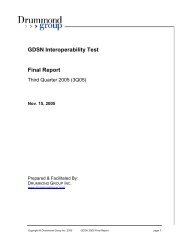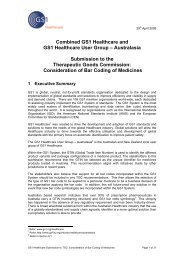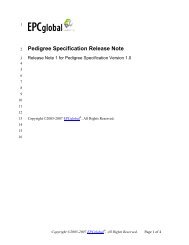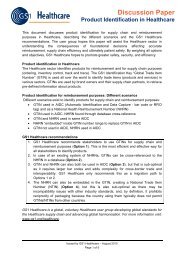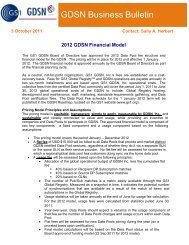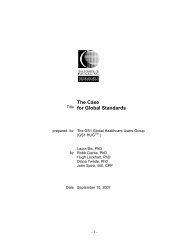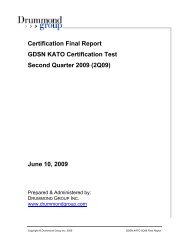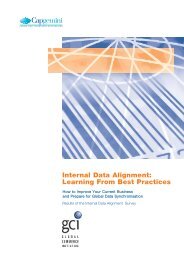SBDH Technical Implementation Guide - GS1
SBDH Technical Implementation Guide - GS1
SBDH Technical Implementation Guide - GS1
Create successful ePaper yourself
Turn your PDF publications into a flip-book with our unique Google optimized e-Paper software.
Standard Business Document Header (<strong>SBDH</strong>) Version 1.3 - <strong>Technical</strong> <strong>Implementation</strong> <strong>Guide</strong><br />
1.4. Process<br />
The [<strong>SBDH</strong>]standard provides a document header which identifies key data about a specific business<br />
document. Since [<strong>SBDH</strong>] standardizes the data presentation, the data elements within the <strong>SBDH</strong> can<br />
be easily located and leveraged by multiple applications. Software vendors can develop functionality<br />
in their applications that rely on the existence and location of the essential data used to manage the<br />
routing of business documents and also systematically determine the documents processing<br />
requirements.<br />
The <strong>SBDH</strong> is a business document header and should not be confused with a transport header. The<br />
<strong>SBDH</strong> is created before the transport routing header is applied to the document and is retained after<br />
the transport header is removed. Although the <strong>SBDH</strong> is not the transport header, data in the <strong>SBDH</strong><br />
can be used by transport applications to determine the routing header since it does contain the<br />
sender, receiver and document details. It can also be used by the business applications to determine<br />
the appropriate process to perform on the business document.<br />
[<strong>SBDH</strong>] has built in flexibility by the use of both mandatory data elements and additional optional<br />
elements. The mandatory elements are essential in identifying any business document for routing or<br />
processing, such as the Sender, Receiver, Document Type, Standard and Version, and Date/Time of<br />
the documents creation. Optional elements provide additional functionality that can be used if<br />
required. This additional functionality can be used to:<br />
■<br />
■<br />
■<br />
■<br />
■<br />
Send EDI, XML or other file types as attachments<br />
Secure business documents with encryption while leaving the <strong>SBDH</strong> unencrypted and<br />
available to perform its routing functions<br />
Describe attachments in a Manifest<br />
Sent the business document within the <strong>SBDH</strong> or sent it as a separate MIME part<br />
Distribute a document to a specific receiver or to multiple receivers<br />
1.5. Document Conventions<br />
The keywords MUST, MUST NOT, REQUIRED, SHALL, SHALL NOT, SHOULD, SHOULD NOT,<br />
RECOMMENDED, MAY and OPTIONAL, when they appear in this document, are to be interpreted as<br />
described in [RFC2119] as quoted here:<br />
■<br />
■<br />
■<br />
■<br />
■<br />
MUST: This word, or the terms "REQUIRED" or "SHALL", means that the definition is an<br />
absolute requirement of the specification.<br />
MUST NOT: This phrase, or the phrase "SHALL NOT", means that the definition is an<br />
absolute prohibition of the specification.<br />
SHOULD: This word, or the adjective "RECOMMENDED", means that there may exist valid<br />
reasons in particular circumstances to ignore a particular item, but the full implications must<br />
be understood and carefully weighed before choosing a different course.<br />
SHOULD NOT: This phrase, or the phrase "NOT RECOMMENDED", means that there may<br />
exist valid reasons in particular circumstances when the particular behavior is acceptable or<br />
even useful, but the full implications should be understood and the case carefully weighed<br />
before implementing any behavior described with this label.<br />
MAY: This word, or the adjective “OPTIONAL”, means that an item is truly optional. One<br />
vendor may choose to include the item because a particular marketplace requires it or<br />
because the vendor feels that it enhances the product while another vendor may omit the<br />
same item. An implementation which does not include a particular option MUST be prepared<br />
to interoperate with another implementation which does include the option, though perhaps<br />
with reduced functionality. In the same vein an implementation which does include a particular<br />
July-2007, Issue 1 All contents copyright © <strong>GS1</strong> 2007 Page 5 of 21






